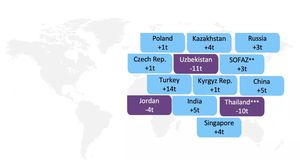Greenland’s Prime Minister Múte Egede has formally announced ambitions for independence from Denmark following provocative comments from U.S. President Donald Trump, who expressed interest in purchasing the island territory. During his New Year’s Day speech, Egede reflected on the momentum for self-governance, asserting, “The Greenlandic people’s opportunity for independence has been adopted through the provisions of the Self-Government Act, thereby creating a legal basis for how independence can be achieved.”
Trump's remarks on December 22, 2024, reiterated the U.S. perspective on Greenland's geopolitical significance, describing it as necessary for national security. He remarked on his social media platform, noting, “For purposes of National Security and Freedom throughout the World, the United States of America feels the ownership and control of Greenland is an absolute necessity.”
Egede swiftly responded, declaring Greenland was not for sale, emphasizing, “Greenland is ours. We are not for sale and will never be for sale. We must not lose our long struggle for freedom.” His statements capture the intricately woven emotions of Greenlanders about their identity and autonomy.
Emphasizing the tangible steps toward autonomy, Egede highlighted important infrastructure developments, such as the opening of new international airports, which he noted would facilitate independent connections from other countries—bypassing Denmark entirely. This, he argued, paves the way for self-determination, requisite for any future independence. He proclaimed, “It will now be possible for us to develop and govern our country more independently.”
While Egede embraces the potential for independence, the reactions within Greenland are mixed. According to recent polls, 84% of Greenlanders desire independence from Denmark; yet, 85% express opposition to joining the U.S. This nuanced sentiment has drawn allies within the local population. Influencer Qupanuk Olsen, who commands considerable online presence, stated her commitment to utilizing the U.S. interest productively. “I have chosen not to be afraid… How can we make the best deal out of this? How can we turn it to something profitable or useful for our future here?” she reflected, urging her fellow Greenlanders to engage with this period of transformation.
Many Greenlanders, like local residents, resonate with the call for self-governance and independence. One anonymous resident shared, “I think what Greenland is really striving for is self-governance and independence. Denmark’s financial and economic support is important, but I can see why the U.S. is interested.” Such perspectives reveal the complex relationship between historical ties and contemporary aspirations for autonomy.
Greenlandic Member of Parliament Pele Broberg acknowledged Trump’s unintentional role as somewhat of an advocate for their cause. “You have to admit, Trump has done a lot of good for the independence movement. When he’s not in office, people don’t care about Greenland,” Broberg said. His sentiments point toward how the U.S. interest can simultaneously serve as both threat and opportunity. Greenland seeks to traverse this delicate pathway by negotiating beneficial terms with the U.S. without entirely severing ties with Denmark.
Yet, the feeling among many remains conflicted; aspirations for autonomy depend heavily on maintaining economic stability without jeopardizing current living standards. Polls indicate many Greenlanders desire independence but only if such aspirations do not diminish their quality of life. The path to sovereignty is not simply about freedom from Danish governance, but rather finding a workable structure for the future.
The balancing act between independence and autonomy is framed against the backdrop of global geopolitics. The geopolitical value of Greenland, with its strategic location and vast natural resources, adds another layer to the already complex discussion. With mounting interest from global powers like the U.S. and China, Greenland navigates through these dynamics, seeking to assert its place on the world stage.
Greenland’s independence movement is more than just local sentiment; it reflects broader themes of post-colonial self-determination and indigenous rights. The resilient spirit of the Inuit people is at the forefront of this movement, as they seek to define their own future amid geopolitical maneuvering.
While the desire for independence is palpable, it is not without complexity. The experience of Greenlanders shows the pressing need to reassess their identity and governance styles as they move toward potential sovereignty. Egede’s administration stands at the dawn of possible change, with hopes high for the coming years.
Each step taken by Greenland toward independence is paved by the persistent hopes of its people. Balancing the delicate interplay between past ties and future independence awaits clarification. The resilience and determination of the Greenlandic people will guide the emergence of their independent path.



